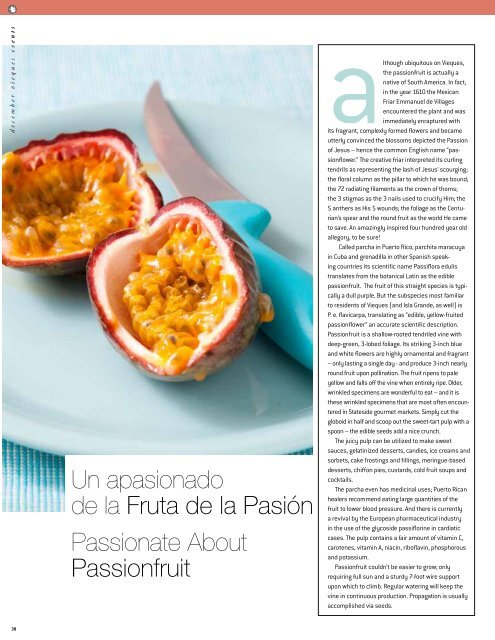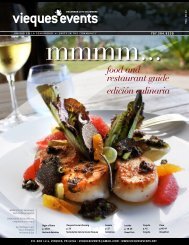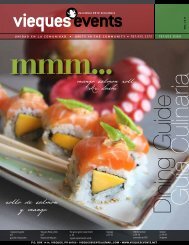GuÃa de Restaurantes - Vieques Events
GuÃa de Restaurantes - Vieques Events
GuÃa de Restaurantes - Vieques Events
You also want an ePaper? Increase the reach of your titles
YUMPU automatically turns print PDFs into web optimized ePapers that Google loves.
<strong>de</strong>cember vieques events<br />
Un apasionado<br />
<strong>de</strong> la Fruta <strong>de</strong> la Pasión<br />
Passionate About<br />
Passionfruit<br />
although ubiquitous on <strong>Vieques</strong>,<br />
the passionfruit is actually a<br />
native of South America. In fact,<br />
in the year 1610 the Mexican<br />
Friar Emmanuel <strong>de</strong> Villages<br />
encountered the plant and was<br />
immediately enraptured with<br />
its fragrant, complexly formed flowers and became<br />
utterly convinced the blossoms <strong>de</strong>picted the Passion<br />
of Jesus – hence the common English name “passionflower.”<br />
The creative friar interpreted its curling<br />
tendrils as representing the lash of Jesus’ scourging;<br />
the floral column as the pillar to which he was bound;<br />
the 72 radiating filaments as the crown of thorns;<br />
the 3 stigmas as the 3 nails used to crucify Him; the<br />
5 anthers as His 5 wounds; the foliage as the Centurian’s<br />
spear and the round fruit as the world He came<br />
to save. An amazingly inspired four hundred year old<br />
allegory, to be sure!<br />
Called parcha in Puerto Rico, parchita maracuya<br />
in Cuba and grenadilla in other Spanish speaking<br />
countries its scientific name Passiflora edulis<br />
translates from the botanical Latin as the edible<br />
passionfruit. The fruit of this straight species is typically<br />
a dull purple. But the subspecies most familiar<br />
to resi<strong>de</strong>nts of <strong>Vieques</strong> (and Isla Gran<strong>de</strong>, as well) is<br />
P. e. flavicarpa, translating as “edible, yellow-fruited<br />
passionflower” an accurate scientific <strong>de</strong>scription.<br />
Passionfruit is a shallow-rooted tendriled vine with<br />
<strong>de</strong>ep-green, 3-lobed foliage. Its striking 3-inch blue<br />
and white flowers are highly ornamental and fragrant<br />
– only lasting a single day - and produce 3-inch nearly<br />
round fruit upon pollination. The fruit ripens to pale<br />
yellow and falls off the vine when entirely ripe. Ol<strong>de</strong>r,<br />
wrinkled specimens are won<strong>de</strong>rful to eat – and it is<br />
these wrinkled specimens that are most often encountered<br />
in Statesi<strong>de</strong> gourmet markets. Simply cut the<br />
globoid in half and scoop out the sweet-tart pulp with a<br />
spoon – the edible seeds add a nice crunch.<br />
The juicy pulp can be utilized to make sweet<br />
sauces, gelatinized <strong>de</strong>sserts, candies, ice creams and<br />
sorbets, cake frostings and fillings, meringue-based<br />
<strong>de</strong>sserts, chiffon pies, custards, cold fruit soups and<br />
cocktails.<br />
The parcha even has medicinal uses; Puerto Rican<br />
healers recommend eating large quantities of the<br />
fruit to lower blood pressure. And there is currently<br />
a revival by the European pharmaceutical industry<br />
in the use of the glycosi<strong>de</strong> passiflorine in cardiatic<br />
cases. The pulp contains a fair amount of vitamin C,<br />
carotenes, vitamin A, niacin, riboflavin, phosphorous<br />
and potassium.<br />
Passionfruit couldn’t be easier to grow; only<br />
requiring full sun and a sturdy 7-foot wire support<br />
upon which to climb. Regular watering will keep the<br />
vine in continuous production. Propagation is usually<br />
accomplished via seeds.<br />
38

















